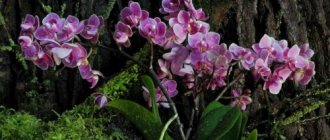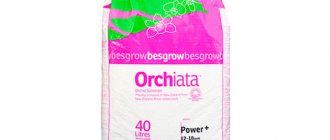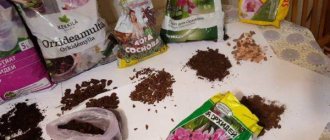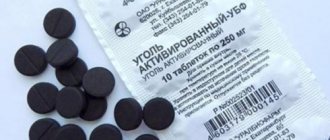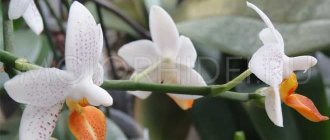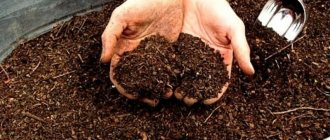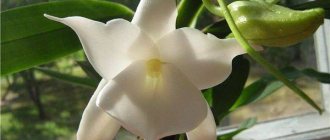Most types of indoor orchids are epiphytes. The roots of these plants do not sink into the ground, but are located on top of the branches and trunks of trees. In nature, phalaenopsis have adapted to do without soil and obtain nutrients from water flowing down the bark of a tree.
In indoor culture, such plants are grown in special soil. The soil for the Phalaenopsis orchid is fundamentally different from the soil for other indoor plants. It is devoid of soil and has special properties necessary to provide orchids with comfortable living conditions.
Phalaenopsis with “open” roots: specifics of cultivation
When transferring phalaenopsis from an old substrate to keeping it in a plug or with a bare root system, the orchid has difficulty adapting - it loses leaf turgor, and its substrate roots may dry out.
Only the new leaves and roots that the phalaenopsis will grow will feel good and familiar.
Not all orchids of this species like to grow in glass vases without a substrate.
Here it is important to guess the desire of the flower so as not to dry out the plant. When growing on a block with open roots, moisten the roots every other day, or every day depending on air humidity
Of course, caring for them is problematic: frequent watering, the inability to leave for a while, but the roots of such orchids are healthy and they grow well
When growing on a block with bare roots, moisten the roots every other day, or every day, depending on air humidity. Of course, caring for it is problematic: frequent watering, the inability to leave for a while, but the roots of such orchids are healthy and grow well.
Why does an orchid need a transparent pot?
A transparent pot is a must.
Firstly, you will see how the orchid's roots grow and determine in a timely manner when you need to transplant the flower into a larger pot.
But most importantly, you can accurately determine when the orchid needs to be watered. And excess water is extremely harmful for this plant. If bubbles of moisture are visible on the inner wall of the pot, then there is no need to water the orchid.
Watch the video to see what pot you need for orchids.
Video on how to propagate orchids by children on a peduncle that does not have roots.
Review: Soil for orchids ZeoFlora - Feeding for home beauties - orchids.
Good day to everyone, dear readers! I like indoor plants, but I take care of them somehow spontaneously, so the only plants left are those with which there was mutual love and a desire to see each other further) One of these plants includes orchids. Now I have six of them and they are in dormant mode, that is, they do not bloom. Usually on New Year's Eve they begin to delight with their beauty.
To care for them, for several years I purchased fertilizers and certain types of soil that suited me, but I decided to try something new for myself - a new moisture-retaining soil. What motivated me was that, having once left for two weeks, upon arrival, two dead flowers were waiting for me (those on whom I left them did not water them and from the heat of the radiators they dried out - it was not possible to restore them), so the peculiarity of the soil is that it retains moisture for me was important.
The soil is in the form of medium-sized balls, reminiscent of those that are placed on the bottom of flower pots (expanded clay). According to the manufacturer, the soil saturates the plant with microelements and retains moisture.
I admit that at first I was afraid to plant my pets in “stones”, somehow it didn’t fit that they would get everything they needed from the stones, so I planted two orchids, filling them halfway, and only added a little to one. On the packaging there is information that you need to add from 20 to 90 percent of the total soil mass.
The packaging looks standard – it’s a bag with the contents – stones.
When watering, this soil makes hissing sounds) Immediately after replanting, I noticed that one orchid’s existing green sprouts began to dry out. Of course, this upset me, but I did not return them to their previous soil. As a result, the old roots dried out and new ones began to appear - dark green and juicy. On another plant a bud emerged, a future flower.
I’ll add that during this period I also spray the top of the leaf with liquid fertilizer once every two weeks. I won’t say that this soil is somehow better than the previous one (you can read a review about it here), in theory, the usual one with liquid fertilizer was enough for me. Although with “Zeo flora” and plus liquid fertilizer I noticed faster growth and new dark roots, I had never seen anything like this before. As for moisture retention, I can’t say that it is obvious: I placed the pots in a bowl of water to soak them in moisture for 20-30 minutes , but the additive still dried out quite quickly, although now is the heating period and it’s warm on the windowsill where the flowers are. Maybe in the summer season the moisture will linger longer.
It is in vain that the manufacturer called it “soil”, because in essence it is just a fertilizer or soil improver, and not an independent soil. For those who want fast growth and flowering, “Zeo flora” will definitely come in handy. The cost of the package is about 260 rubles.
Why is it so important to choose the right soil composition?
When growing tropical crops such as orchids, one must understand their epiphytic nature. They feed on decaying plants, atmospheric moisture and sunlight.
The correct soil for orchids is very important, because it will allow the flower to actively grow, develop, bloom for a long time and not be susceptible to disease. In addition, thanks to the well-selected composition of the soil, there will be no need to apply fertilizers for one or two years before the next plant replanting, since the available components will sufficiently nourish the root system.
Pros and cons of the finished substrate
What is good about purchased substrate:
- Convenient packaging - measured in liters, suitable for calculating how many orchids need to be replanted.
- There are ready-made mixtures that do not require additional moss or drainage.
- There are soils that are additionally enriched with minerals. This makes it possible not to feed the plants additionally.
- Manufacturers produce different formulations: complex and monocomponent, depending on the type of epiphyte and the individual preferences of its owner.
Among the disadvantages are the average quality of some brands, where production allows:
- uneven fraction of bark and expanded clay;
- inclusions of debris or debris;
- parasite infection.
There are packagings where it is impossible for the buyer to examine the condition of the product, and when opened, mold, mustiness and other imperfections are revealed.
Homemade or purchased mixture: which is better?
It is difficult to say unequivocally what will be better for your plants - a ready-made mixture or one made with your own hands. If you are just starting to get acquainted with these flowers and decide to plant phalaenopsis or cattleya, then it is unlikely that you will be comfortable understanding the relationships between moss and bark.
It is much easier to read a number of reviews and purchase ready-made soil without bothering, and then rely on your experience, trying out different types of combinations.
An experienced breeder develops his optimal composition, depending on how many species there are and which ones. For some it’s just boiled bark, while others prefer adding expanded clay or coconut base. Sometimes only personal experience helps to find the best solution.
Top best soils
The most affordable soils can be considered (from 59 rubles per 1 liter):
- Geolia;
- "Black Gold";
- "Flower Happiness";
- "Fasco";
- "Ambulance".
“Living World” also has an affordable price, but is not found in all cities of Russia. The same can be said about the Black Gold soil. In terms of composition, Seramis is most praised (from 571 rubles for 5 liters), although its mixture contains a lot of fine fractions. Kekkila “Ceoflora” and Geolia have proven themselves well on the flower growers’ forums.
The most negative reviews are found among users of the “Ambulance” soil, where both mealybugs and fungus gnats were found in some of the packs.
Quality criteria
The selected substrate for orchids should not cause root rot and should conduct air, as well as light (for plants with roots that absorb it through photosynthesis). The following requirements apply to the soil :
- must not contain garden soil;
- must be able to hold the orchid in an upright position;
- must have good throughput (retain minimal moisture).
Reference! When selecting components, they are convinced not of nutritional value, but of the structure and moisture permeability of the soil.
How to determine the quality of purchased soil
Most often, defects are not production defects, but as a result of improper storage or incorrect delivery.
Pay attention to the following points:
- The name should indicate whether the substrate is universal or intended only for epiphytic orchids. It’s good if you can purchase a substrate specifically for phalaenopsis.
- Carefully read the composition of the components. This can be verniculite, expanded clay, bark, swamp moss, chips or coconut fiber, but earthen soil is excluded.
- If the packaging is not transparent, check it by touch. The fractions inside should be no more than 3 cm. There may also be small inclusions, but this should not resemble dust or small crumbs.
Upon visual inspection, the soil is a mixture of medium and large fractions; it should not be black in color, similar to soil.
What to rely on when choosing?
When choosing ready-made soil for orchids, you need to understand exactly what composition is needed specifically for your plant. If you have unpretentious Phalaenopsis, Dendrobium, the product that contains the following will be suitable :
- bark;
- charcoal;
- sphagnum moss.
Wanda, Miltonia, Dracula need other components.
Some gardeners prefer one-component substrates to create their own soil based on them. In this regard, “Effect Bio” with pieces of bark of various sizes is convenient.
Universal soil is not suitable for whimsical, demanding varieties of epiphytes , and Phalaenopsis feels good even without a premium mixture.
Substrate without mold
The appearance of mold in a pot is usually caused not by the quality of the substrate, but by errors in caring for phalaenopsis. Probable causes: excess moisture, insufficient air circulation, poor lighting, low temperature and impervious heavy soil.
Prevention measures
Watering phalaenopsis should be done only after the substrate has completely dried. The interval between moisturizing depends on the time of year and the location of the orchid.
In winter, the frequency of watering is significantly reduced.
At this time, it is especially important to avoid drafts. It is necessary to select a pot for phalaenopsis based on the size of the root system, increasing the volume of the container with each subsequent replanting
It is necessary to select a pot for phalaenopsis based on the size of the root system, increasing the volume of the container with each subsequent replanting.
Orchids need to be provided with good lighting and ventilation - fresh air circulation prevents the formation of mold. Do not confuse adequate ventilation with drafts.
Problem solving
When mold appears, it is necessary to reconsider the conditions under which the orchid is kept.
Procedure:
- Remove affected soil components.
- Add a new substrate with the addition of perlite, activated charcoal and charcoal.
- Spray the ground part of the orchid with Fundazol. The composition of the solution is 2 g of the drug per 2 liters of water.
If the roots are damaged, then it is necessary to replant the phalaenopsis in the spring after flowering. Until this time, watering is noticeably reduced.
During transplantation, the root system must be disinfected - treatment with a solution of potassium permanganate will do.
Before reusing the pot, the container must be treated with a fungicide.
Novice gardeners sometimes mistake limescale deposits for mold, which can form due to the use of hard water for irrigation.
The substrate for phalaenopsis orchids is significantly different from the usual soil for planting indoor flowers. And the tasks assigned to him are completely different. By and large, the components of the substrate should serve as a good support for the orchid, provide aeration of the roots and gradually release moisture accumulated after watering.
What substrate for phalaenopsis do you prefer? What proportions do you follow when mixing the components, or do you buy ready-made soil? Please tell readers about your experience growing indoor orchids.
Growing
In the moss
Many flower shops offer mini-phalaenopsis, purchased in small pots along with moss. This chosen planting method requires the use of skills in the process of caring for orchids.
To successfully grow these flowers, you can use live or dried prepared Sphagnum moss or ready-made peat moss, which is placed in a pot in its pure form without any additions. This allows you to transport the plant, as well as keep it in an apartment or a spacious greenhouse.
Advantages of moss substrate:
- accessibility and widespread use;
- low cost;
- cleanliness and high moisture capacity.
The disadvantages of this material are a fairly high acidic environment, the possibility of moisture stagnation in the container and, as a result, rotting, as well as the destruction of sphagnum over time. Before planting the orchid, the pot is filled 1/3 with moss, and then the plant is planted in it. The resulting voids near the roots are necessarily filled with the remains of moistened sphagnum. Tamping is not done to leave space, which allows air to enter.
In the future, the main feature of proper care for an orchid growing in such a substrate is to ensure the correct and timely watering regime. The plant is sprayed, gently watered from above or placed in the humid atmosphere of a spacious greenhouse. It is not allowed to overdry due to the possible transformation of sphagnum into dust.
In a nutrient medium
Germination of orchid seeds is possible in symbiosis with fungi, and for such an artificial process a nutrient medium or an appropriate prepared substance can be used. In appearance, it is a gel-like mass consisting of water and added agar-agar, glucose and other elements.
In polystyrene foam
This synthetic, fairly porous material perfectly replaces the epiphytic substrate and has such advantages as inertness, lack of rotting, low weight and the ability to use granules to loosen the soil layer. Large pieces can be used for drainage and to create blocks for orchid seedlings.
Advantages of growing flowers in polystyrene foam:
- no rotting of stones;
- sterility;
- excellent aeration.
The disadvantages include almost zero moisture capacity, frequent fertilizing and the low decorative value of such material.
Soil for phalaenopsis - basic requirements
A high-quality substrate for phalaenopsis should be:
- light and moisture-absorbing;
- do not interfere with the natural circulation of air around the roots;
- provide looseness;
- have the ability to retain nutrients;
- have an acidity level of 5.5 to 6.5 pH;
- dry in 3 days;
- let in enough light.
If phalaenopsis is grown in a basket or on a block, when the risk of soil drying out is high, the composition is supplemented with components that retain moisture for a long time. Options include bog moss, fern roots and coconut chips.
When purchasing or preparing soil, take into account the individual conditions of keeping phalaenopsis
The higher the illumination and the longer the daylight hours, the faster the metabolic processes in the orchid go, the more it grows green mass and absorbs water.
If the phalaenopsis is in a warm, sunny place where the humidity does not exceed 40%, then it will feel great in soil with the addition of moss and a small amount of peat.
For dark windows that are obscured by trees or houses, the substrate should be airy and less moisture-intensive
The orchid here grows when the sun hits it. She has a slow metabolism, and the moisture in the substrate takes a long time to absorb.
Preparing soil at home
The most important step in the soil preparation process is preparing the components. This requires collecting them yourself or purchasing them in a store, preparing everything you need, as well as allocating time and the required amount of space for the planned process.
Bark and fallen leaves are harvested at the onset of autumn. When using coniferous planting materials, less resin and mold should be present on the bark. As a rule, sphagnum moss is collected in the fall with fallen leaves. Birch charcoal is obtained by burning logs, and sand is mined on the shore of a reservoir.
The finished components are mixed together in the required proportions. Then the prepared substrate is sterilized. Before use, it is moistened with water from a spray bottle.
Advice! The substrate must be prepared immediately before use with the addition of a small amount of the old composition, which allows the introduction of beneficial microflora.
Soil composition
This product has high moisture capacity. Moisture, penetrating into the pores of the granules, is contained there without harming the plants. The granulate releases as much water as the orchid requires, without having a detrimental effect on the roots of the flower.
It is also important that, due to their shape, the granules allow oxygen to pass through, which is no less important for the development of the plant. It is safe for humans and animals
The Zeoflora product has sorption and cation exchange properties. The composition contains active silicon, which provides the necessary conditions for the development of the root system of the flower, and also develops its resistance to stress. Nitrogen and potassium contained in the composition also have a positive effect on the condition of the plant. The use of soil rich in useful microelements helps reduce the amount of fertilizing.
Questions and answers
Is it possible to transplant an orchid into ordinary soil?
This flower cannot be transplanted into ordinary soil due to the weakness and unadaptability of the root system to the heavy substrate. After transplantation, the roots begin to hurt, so the plant disappears even with normal looseness of the soil.
What kind of soil is needed for transplanting a baby?
For this procedure, a special prepared well-balanced soil is selected, which consists of crushed pine bark, sphagnum and charcoal.
How often should the substrate be renewed?
The substrate for orchids is changed immediately after purchase, every two to three years , and also immediately if there is a significant deterioration in flower growth.
general description
Zeoflora (ZeoFlora) is a ready-to-use soil that is suitable for growing flowering indoor plants, incl. for species of the orchid family.
It has sorbing and cation exchange properties and is suitable for growing orchids both using drainage and in a closed system.
It is characterized by an increased ability to retain moisture, which accumulates inside the granules and is consumed by flower roots as needed, giving away as much water as required.
Release forms
The substrate for orchids is available in granular form in packages of 2.5 - 5.0 liters. The diameter of the granules varies from 0.5 to 0.9 mm. The color is light brown.
Cost - 330 rubles for 2.5 liters.
Compound
The granular soil mixture consists of a natural material - zeolite, which has undergone a firing procedure under high temperatures.
It contains additives important for the health of flowers:
- silicon, necessary for flower crops for proper development of the root system and resistance to external factors;
- nitrogen, which acts as a source of active formation of green mass and abundant flowering;
- potassium, which ensures intensive shoot growth.
Advantages
- The air permeability of individual granules saturates plant roots with oxygen, which is important for their full development.
- The accumulation of water in the granular structure of the soil mixture protects the root system of home flowers from waterlogging, provides a dosed supply of moisture as required and reduces the need for frequent watering.
- The sterility of the granulate creates reliable protection against the ingress of pathogenic microflora and protects orchids from the appearance of infectious diseases and pest damage.
- The rich mineral composition acts as a source of consumption of orchid substances useful for development and replaces other feedings.
- The soil is non-toxic and absolutely safe for humans and animals.
- Does not require disposal after the death of the plant contained in it. We will use it more than once. It retains its beneficial qualities for a long time and can be reused after preliminary calcination in the oven.
- Simplifies planting and subsequent care of orchids
Kinds
Ready-made substrates for orchids are available in various volumes (from 1 to 6 liters), containers (bag, doy-pack, plastic bucket) and composition. Let's list the most common ones.
Kekkila (Finland)
Designed for all types of orchids. The basis of the soil is:
- charcoal;
- expanded clay crushed stone;
- tree bark;
- sphagnum.
The advantage of the soil is that it has a rough structure that is as close as possible to natural conditions. Such fibers allow air to pass through well. Does not contain fertilizers or additives.
Disadvantage: not sold in small quantities, supplied in a package for 6 liters (about 2 kg).
Cost: from 338 to 635 rubles. per package. Found in specialized and online stores (vash-dachnyi.ru, kapelka.com).
Geolia
Declared as a premium class primer. Contains: natural pine bark, sphagnum moss and charcoal, packaged in a separate bag. Suitable for all types of orchids, including Paphiopedilum, Kalanthus, Miltonia.
Product advantages:
- convenient packaging with a transparent window through which you can see the condition of the substrate;
- ranking the layers so that they can be selected and mixed in the quantity required by the grower;
- All pieces of bark and coal are the same size.
Price: 2.5 liter packaging can be found in Leroy Merlin from 66 rubles, on small Internet sites (shop.plantship.ru) - 79 rubles.
"Living World" (Belarus)
The substrate is nutritious and suitable for all types of epiphytes. It consists of fractions of pine bark (steamed), expanded clay of different sizes.
Pros:
- can be used as an addition to a self-made substrate to add lightness to the base;
- the bark does not require additional heat treatment.
Flaws:
- contains a lot of chip dust, in some bags the bark is chopped into thin strips;
- small packaging.
Price: 1.5 liter package - 115 rubles. (Ozon.ru), “Obi” - 159 rubles, can also be found in large chain stores with gardening departments.
"Ambulance"
Consists of a mixture of 50% high-moor peat and 50% pine bark.
Designed for unpretentious orchids (Phalaenopsis, Cambria, Oncidium, Cattleya and others), but can be used as a component for the soil of other, more demanding species.
Plus - uniformity of components in size, medium-sized pieces of bark.
Minus:
- there are specimens infected with fly and fungus gnat worms;
- Not everyone likes its looseness.
Price range - from 52 rubles. for 1 liter. Found in the assortment of Perekrestok-Online, Magnit stores, and household departments.
“Effect Bio” (NPO BioTechnology, Russia)
It consists entirely of bark (Angarsk pine). The manufacturer promises processing of the material, but in some packages the pine is muted in color and dried. There are different degrees of fraction: 8-13 mm, 13-19 mm, 19-28 mm. It has a wide range of uses, including not only for planting orchids.
Advantages:
- ability to choose the size of the pieces;
- easy to mix with other ingredients for manual production;
- the smallest fraction is optimal for mini-varieties.
Cons: not suitable for beginner gardeners who want to immediately buy ready-made soil with all the components.
Price range: 300 rub. on the manufacturer’s website (from 165 rubles wholesale), Beru.ru - 270 rubles, Ozone - 394 rubles. It can also be found on the shelves of hypermarkets, hardware departments and seed stores.
"Ceramis" (Germany)
Granules for planting. The composition contains Portuguese pine bark, a large fraction of clay, calcium fertilizers from lime and dolomite in the form of drainage balls.
The advantage of the soil is its lightness; the pieces of bark are approximately the same size and cut thickly, without extra sticks or debris.
Minuses:
- you come across a lot of rotten pine particles, which form the basis of the granulate, because of this, parts of the soil seem small;
- high price.
Cost: on Wildberries.ru 2.5 liters costs from 571 to 601 rubles, Ozon.ru - from 525 rubles. According to customer reviews, it is rarely found on the open market; it is more often purchased via the Internet.
"Black Gold"
It is a universal soil, which means it is suitable for most orchids of different ages: from teenagers to perennials. Most of it is occupied by coconut substrate with the addition of pine bark, which will give the filler additional aeration.
Pros:
- has no smell;
- suitable for repeated use;
- The manufacturer promises the absence of parasites and pathogenic microflora.
Cons: Requires the addition of additional components.
Price: from 108 rubles for 2 liters in flower shops, rarely found in hypermarkets.
"Flower Happiness"
Presented as a soil of universal properties with microelements. Includes:
- larch bark;
- high peat;
- expanded clay drainage;
- coal.
Designed for most epiphytes:
- Cattleya.
- Phalaenopsis.
- Cymbidium.
- Miltonopsis and others.
Among the disadvantages, buyers name:
- excessive dryness of the substrate;
- large fragments of expanded clay;
- heterogeneity of pieces of bark.
The advantages are the cleanliness of the soil from pests and the presence of micronutrients.
Approximate price - from 65 rubles. up to 121 rub. for 1 liter. Sold in all hardware departments of super- and hypermarkets, can be purchased on the Internet sites Ozon.ru, Order.ru.
"ZeoFlora"
Retains moisture well. Consists of 100% natural calcined mineral - zeolite. The product is used as a base for primer or as a conditioning additive. The presence of microelements inside the zeolite gives the effect of feeding in the dose required for the orchid.
Pros:
- sterility of the composition;
- does not break down with water and does not become compacted over time;
- the root system of the plant is stimulated due to the presence of a complex with phosphorus, potassium and silicon in the mineral;
- the porosity of the structure ensures better air penetration;
- It will be almost impossible to “re-water” flowers with it.
Disadvantage: monocomponent, there is no usual set of bark and moss.
Cost: from 285 rubles per 2.5 liter package , available for free sale both in online stores and in specialized outlets.
"Veltorf"
Suitable for stimulating the growth of orchids and their nutrition. It has the properties of a fertilizing fertilizer in the presence of nitrogen, phosphorus and potassium in a dosage that is safe for the plant. Inside the package is a mixture of milled peat, limestone materials for drainage and large shaped pine bark.
Pros:
- contains organic substances without unnecessary impurities and debris;
- soil versatility.
Cons: non-classical composition, which is not suitable for demanding varieties of epiphytes.
Price: 85 rub. for 5 liters (Ozon.ru), from 44 rubles. in small wholesale stores for gardeners and gardeners.
"Fasco"
Ready for use immediately, it has nutritional properties. Suitable for the most common types of orchids, including bromeliads. Maintains a high level of decorativeness of plants.
The composition states:
- drainage particles (expanded clay);
- peat;
- coal;
- tree bark.
Advantages:
- a comprehensive composition that meets the needs of most beginner gardeners;
- the presence of expanded clay and coal will prevent the soil from compacting and promote air exchange;
- more often than other brands found in stores.
Disadvantages: unevenness of the substrate, the bark is often not processed and has resin residues.
Price: “Russian Garden” chain - 59 rubles. for 2.5 liters, Ozon.ru - from 145 rubles. up to 160 rub. for the same volume (prices depend on the region of purchase and the seller). It is also easy to find in most chain supermarkets for household goods.
What does the substrate for orchids consist of?
The substrate for orchids can consist of different fillers, I will talk about them in more detail below. But when choosing a preparation in a store or assembling it yourself, it is worth remembering the main tasks that the mixture should solve:
- Good at absorbing moisture. This is necessary for the uniform release of water to the plant and the removal of excess liquid.
- Dry quickly to prevent roots from rotting.
- Allow enough air to keep conditions close to natural.
- Saturate the environment with nutrients.
Stores often sell ready-made bark-based mixtures for orchids. They meet basic requirements and are used successfully by many breeders. The main risk is that the substrate may cake and deteriorate during storage. Also, the industrial harvesting method is not capable of ensuring a sufficiently thorough selection of bark, so the set will contain pieces of different quality.
Orchid bark
The main substrate filler for orchids is bark. Pine is most often used - it is light, absorbs moisture well, dries quickly and is widely available. It's easy to find and prepare. However, you can also find mixtures based on other types: spruce, larch, oak bark. The main thing here is the correct collection and processing of the material.
So what kind of bark do you need? If we talk about conifers, then it is best to collect bark from already dead, dried trees, so it will contain less resin. It is imperative to choose areas that are not damaged by the sun, rot, or pests. For adult orchids, the particle size needed is approximately one centimeter long and wide.
Important components - moss and coal
However, bark for orchids, although the main one, is not the only filler needed. If you are using ready-made substrates, make sure they contain other elements as well. If necessary, add them separately. The most basic components are considered to be the following:
- Sphagnum moss,
- Charcoal.
Sphagnum is the most common moss in Russia. For growing orchids it is used both live and dry. Thanks to its structure, it provides sufficient ventilation of the roots. It is also capable of absorbing large amounts of moisture, performing two functions at once: it retains water and evenly releases it to the plant, and also protects aerial roots from rotting.
In addition, mosses contain a large amount of nutrients needed by orchids. In addition to sphagnum, you can use other types, for example, cuckoo flax. The main thing to remember is that dry mosses decompose quickly, and therefore they need to be changed at least 2 times a year.
Charcoal - most often birch - is used as an absorbent: it absorbs harmful substances, such as excess salts. Small pieces of the same size as orchid bark are added to the pot - 1-2 cm in diameter. It is advisable to replace the coal periodically.
Other components
In addition to the main components of the substrate: pine bark, moss and charcoal, other components are sometimes added. The following additives are common in Russia:
- High peat. It is highly breathable and can absorb large amounts of moisture. However, in the future you will have to deal with excessive soil acidity and also look for additional sources of nutrients. This supplement is good for mature and strong plants.
- Cones, nut shells, and dry fern roots serve simultaneously as a leavening agent, mulch for better ventilation of the roots, and a source of useful micro- and macroelements. Exotic coconut fibers are also suitable.
- Fallen leaves, rice husks. As these components decompose, they will provide the orchid with additional nutrition.
Inorganic components
You can also add inorganic components to the mixture of orchid bark, such that they will be chemically inert, while making the substrate more loose. Some materials also retain moisture well. Most often added:
- Coarse sand - it makes the soil lighter.
- Expanded clay, perlite and vermiculite are used as additional drainage.
- Polystyrene foam and foam rubber are also great for loosening and retaining moisture.
Popular compositions and their characteristics
It’s easy to make soil for phalaenopsis with your own hands. To do this, it is not necessary to use all possible materials. You can get by with fewer components. Here are some popular formulations and their characteristics.
The composition of soil for Phalaenopsis orchids includes only 2 components:
- Pine or fruit tree bark - 5 parts;
- Charcoal – 1 part.
This composition has a reduced moisture capacity and can be used for planting plants with root system problems.
Phalaenopsis orchids, which are prone to rotting, when grown in such a substrate, quickly grow new roots and restore old ones. Charcoal promotes good air circulation and the destruction of putrefactive bacteria.
The following substrate contains 3 popular materials:
- Pine bark and crushed pine cones - 5 parts;
- Dry sphagnum moss – 2 parts;
- Charcoal – 1 part.
This is a more moisture-intensive substrate. It is suitable for planting healthy baby orchids and adult plants.
Complex soil composition for phalaenopsis:
- Pine bark or crushed cones – 5 parts;
- Sphagnum moss – 2 parts;
- Chopped fern roots - 1 part;
- Coconut fiber – 1 part;
- Charcoal – 1 part.
The substrate has excellent moisture holding capacity, but dries quickly and evenly, which is important for the health of the root system. This composition is very loose and does not cake for 2-3 years.
There is also a composition with increased moisture capacity that can be used for planting baby Phalaenopsis orchids and adult plants with insufficiently developed roots or without them at all. In such soil, plants grow their root system well. It has the following composition:
- Fine pine bark – 1 part;
- Dry crushed sphagnum moss – 1 part.
The best soil for phalaenopsis orchids: TOP-6 purchased options
Among all the orchid substrates offered today by the flower market, there are many worthy options. Let us highlight the offers of popular manufacturers - their product meets the requirements of flower growers about what kind of soil is needed for planting phalaenopsis orchids at home.
Orchiata
Orchiata is the bark of the New Zealand pine Pinus Radiata. The substrate is high quality and has a number of advantages over its competitors.
Arguments in favor of orchiata:
- durability - can last up to 7 years;
- breathability;
- absence of toxins and pathogens;
- balanced PH level – 5-6;
- moderate roughness – promotes root fixation;
- no sharp corners.
The manufacturer offers 5 different fractions of Orchiata. The dimensions of the bark, depending on the chosen type, are 3-25 mm.
A significant disadvantage of the substrate is its cost.
Flower happiness
Ready-to-use soil for growing orchids from Russia. The substrate with the addition of peat is balanced and contains complex fertilizers.
All components are optimized for the characteristics of orchid growth and development. The substrate does not contain pathogenic microflora. Its effectiveness has been tested and confirmed by tests
Contains:
- high peat;
- agroperlite or expanded clay drainage;
- moss;
- bark.
Convenient vacuum packaging Doy-Pack with a flat bottom. Content volume – 2.5 and 1 l. The soil is light, crumbly, good quality bark, white moss has been added.
Seramis
It is a complex that includes clay granules, balanced fertilizers and a moisture indicator. It can be used an unlimited number of times for many years.
The basis of the substrate is specially processed clay in the form of porous granules enriched with biologically significant elements - NPK
Seramis regulates the moisture level after watering. The innovative substrate is suitable for different types of orchids.
Seramis has a number of advantages that allow you to choose it:
- when replanting, it does not need to be replaced with a new one; it is enough to add the missing amount;
- over time, its compaction does not occur, the structure remains the same thanks to the smallest pores, the granules regulate the water balance,
- accumulating mineral solutions, and then gradually returning them to the ground;
- the plant can be watered once every three weeks - the humidity indicator will show when it needs to be done;
- All substances necessary for growth are contained in balanced fertilizers.
Seramis eliminates the appearance of mold and insects. The disadvantages of Seramis include its cost and limited availability. Seramis substrate is not available in all flower shops.
Bio effect
This is one of the most common substrates. It contains exclusively organic components. The most basic of them is the bark of the Angara pine.
Substrate Effect Bio is loose, light, breathable. The raw materials are processed and dried
The dolomite flour included in Effect Bio normalizes the acidity level of the soil. The presence of microorganisms in the soil increases the immunity of phalaenopsis and its resistance to stress.
Pokon
Compressed eco-briquette of flower substrate from the Dutch company Pokon.
The list of ingredients includes: coconut fiber and an effective fertilizer - azophosphate (NPK) in a ratio of 20:20:20. Acidity level pH – 5.5-7.0.
Composted soft coconut fibers make the structure of the substrate porous, quickly saturated with air
The supply of nutrients is enough for 2 months. There is no dust or weeds in the soil.
The substrate is very easy to prepare: add 3 liters of water and wait 3 minutes. The substrate is ready for use! The volume of the resulting soil is 10 liters.
Aurica Gardens
"Gardens of Aurica" presents the ideal substrate for phalaenopsis - Orchid Profi. It is a mixture of high quality pine bark, coconut fibers and shavings, charcoal and white moss (sphagnum).
The substrate does not contain peat and expanded clay, which means the risk of root rot and rapid soil salinization is minimized.
Among the advantages of the substrate “Gardens of Aurica”: affordable cost and complete composition. The contents and dimensions of the components can be seen through the transparent packaging
Ceoflora
It contains hydrous aluminosilicate of sedimentary or volcanic origin. This is a natural zeolite stone. It contains metal oxides: potassium, aluminum, silicon, iron, sodium, etc.
The acidity level is neutral, so all these elements are perfectly absorbed.
Substrate Ceoflora Looks like hard clay, has a pearlescent sheen the color of jasper, processed using special technology
The soil is long-lasting, does not compact, does not lose its structure.
The importance of an unmistakably composed substrate: can it be planted in the ground?
The soil for the flower in question serves, first of all, as a support. For this reason, it is subject to special requirements regarding looseness, moisture absorption and breathability.
Phalaenopsis is unlikely to live long in ordinary soil. First of all, its roots, which take an active part in photosynthesis, will rot. Following this, the upper part of the plant will begin to fade. Accordingly, phalaenopsis will definitely not be able to bloom in the wrong substrate.
The nuance is that the root system needs light no less than the leaves. Ordinary land cannot provide this.
Look at any photo of an orchid growing at home in a transparent pot, and you will understand why a regular soil mixture will not work for it.
Components for making your own substrate
Flower shops offer a large selection of ready-made soil mixtures for flowers, including orchids. However, experienced gardeners prefer to collect soil for their pets themselves.
It is not difficult to make an orchid soil mixture, the main thing is to maintain the proportions. If everything is done correctly, the plant will thank the owner with riotous flowering.
To work you will need the following components:
- tree bark, preferably pine;
- refined charcoal;
- coconut fiber;
- small expanded clay;
- peat mixture;
- fern roots;
- bog moss (sphagnum);
- pine cones;
- leaf humus.
All of the above components are not strictly necessary; you can only add to the soil what you find:
- To collect bark, you need to select growing, healthy trees that have clearly peeling bark. The use of a knife and force is not allowed; if you cannot remove it with your hands, you should find another plant. Fallen trunks or stumps can also serve as a source, the main thing is that they are not rotten. It is important to remember that the collected material must be dry; wet material can infect the flower. It is advisable to boil the collected bark for an hour to destroy pests and boil down the resin. In addition, at the end of cooking, it is easier to cut into pieces, which then need to be kept in the oven, heated to 100 C0, until completely dry.
- Charcoal can be taken from a burnt-out fire. The amount of this component is strictly limited (no more than 5% of the total mass), since the salts it accumulates negatively affect the growth of the orchid.
- A mixture of high-moor and low-moor peat is also often introduced into the soil for planting orchids. You should not use crushed peat; it will compact the soil.
- It is preferable to take marsh moss ; above-ground green parts of the plant are used.
- Sometimes, to improve the structure of the soil, its moisture capacity and aeration, fern roots from an adult plant are included.
- Leaf humus is not used for all varieties of orchids and is added in small quantities.
To avoid contamination, the components of the substrate are carefully processed by calcination or boiling and divided into small pieces.
Different types of orchids require different approaches to soil formation:
- For epiphytic species, the ideal option is bark, crushed to 0.5 - 2 cm. You can include a little moss and coconut chips. This soil option is ideal for orchids with a well-developed root system.
- Ground varieties require more moisture-intensive soil: a store-bought mixture is added to the pine bark (2 parts bark to 1 part packaged soil).
The structure of the soil also depends on other factors.
The following options are possible:
- Composition 1: coal and bark in a ratio of 1x5. Used for greenhouse and potted flowers, it has low moisture capacity and good air conductivity.
- Composition 2: coal, sphagnum, pine chips in a ratio of 1x2x5. The mixture is ideal for flowers grown in pots and baskets.
- Composition 3: coal, peat, bark, humus in the proportion 1x1x1x3. Designed for flowers that need additional nutrition.
- Composition 4: peat, polystyrene foam, cork bark, pine bark in the proportion 1x2x3x4. Created for orchids growing on southern windows.
- Composition 5: sphagnum, coal, peat, coniferous tree bark in the proportion 1x1x1x7. This composition is used in low light conditions in the autumn-winter period.
Making your own substrate
When making your own soil for orchids, you need to follow several principles to allow the plant to take root in the new soil and develop well:
- the lower the ambient air humidity, the more moisture-intensive components in the soil;
- the soil should be loose, not compacted;
- Ideally, the substrate should dry out in 3–4 days.
The process of making a mixture consists of the correct processing of all parts included in the soil mixture:
- collected according to all the rules is crushed.
- Peat is divided into fairly large particles.
- The components are thoroughly calcined and dried.
- Freshly collected sphagnum moss is soaked for 24 hours in clean water. The procedure will expel insects that float to the surface.
- Fern roots are washed with running water, preferably with a shower head , doused with boiling water to destroy possible pests, then chopped into small pieces.
- The bottom of the planting container is covered with a layer of drainage consisting of expanded clay, polystyrene foam, small pebbles or crushed stone. Next, up to about half of the pot, comes the soil. The central part of the bowl is also filled with a generous layer of drainage, on top of which the prepared soil is laid out. The container is filled freely, without compaction.
